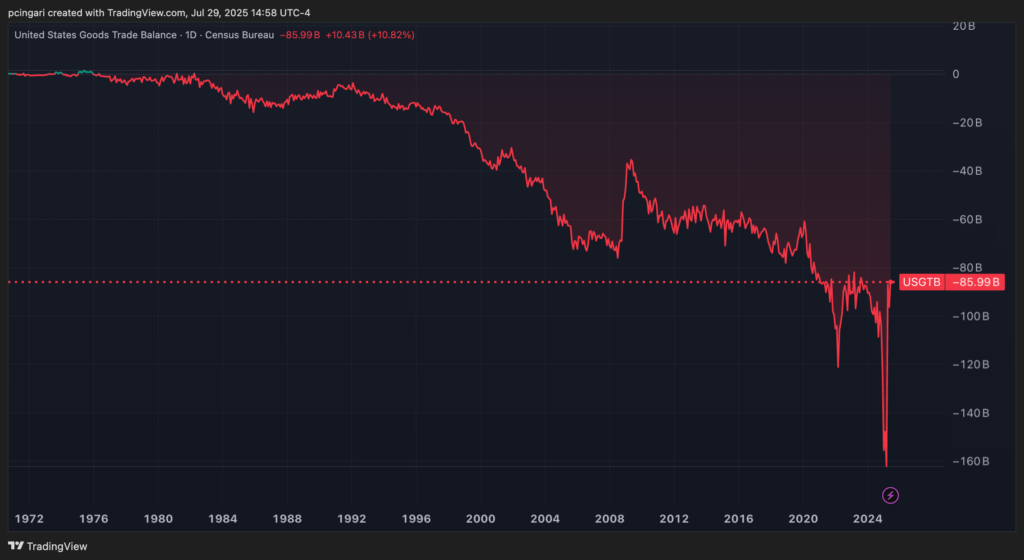Trump Toasts Tariff Victory As Economists Quietly Junk Their Trade Forecasts
When President Donald Trump threatened to hike tariffs on all U.S. trading partners at the start of the year, a rush of foreign goods flooded into the country as businesses scrambled to stockpile inventory ahead of higher costs.
- USO ETF’s momentum accelerates. Track it now here.
That front-loading behavior distorted economic data, with the U.S. economy shrinking 0.5% in the first quarter—the worst performance in three years. Trump's aggressive tariff rhetoric initially seemed to backfire, fueling concerns it was doing more harm than good.
In fact, the record $390 billion trade deficit logged in the first quarter of 2025 was largely a byproduct of the very habit tariffs were meant to discourage: over-reliance on foreign goods.
Each of the first three months of the year posted the worst monthly trade gaps on record.
Now, the script has flipped.
With tariffs taking effect after April 2 Liberation Day, imports are falling quickly—and the U.S. trade deficit is shrinking much faster than most economists projected.
Trump is treating it as a first victory lap—framing his aggressive tariff strategy not merely as leverage, but as a concrete policy success now delivering the first economic gains.
US Trade Deficit Narrows Sharply In June

According to Census Bureau data released Tuesday, the U.S. goods trade deficit narrowed by $10.4 billion in June to $86 billion.
That's far better than Wall Street's forecast of $98.4 billion and marks the smallest trade gap since September 2023.
Imports dropped 4.2% month over month to $264 billion, led by sharp declines in consumer goods, down 12.4% to $58 billion, and industrial supplies, down 5.5% to $48 billion. Capital goods imports held steady near $91 billion.
On the export side, the picture was more stable. Total outbound shipments slipped just 0.6% to $178.2 billion, supported by a 4.7% jump in capital goods exports and a 4% rise in food and beverages.
What Comes Next? A Data Storm
Tuesday's trade data is only the first of several key economic reports this week that could shape investor expectations and Federal Reserve policy.
On Wednesday, the Bureau of Economic Analysis will release the advance second-quarter GDP estimates, with median consensus from Wall Street economists expecting a 2.4% rise.
"Q2 GDP is likely to rise by 2.3% quarter-over-quarter annualized, compared to -0.5% in Q1," Bank of America economist Pedro Diaz said. "That increase is primarily due to a reversal of the Q1 import surge driven by tariff front-loading."
Bill Adams, chief economist at Comerica Bank, is more optimistic. "June's drop in the trade deficit and the rise in inventories boost the outlook for Q2," he said. "We forecast a 2.9% annualized increase, mostly thanks to the collapse in imports."
The Federal Reserve is expected to hold interest rates steady on Wednesday at 4.25%-4.5%. But two FOMC members—Governors Michelle Bowman and Christopher Waller—may dissent in favor of early rate cuts, adding new tension to Chair Jerome Powell's press conference.
Diaz thinks Powell may remain cautious: "He would prefer to see July's data before guiding markets at Jackson Hole."
Then on Thursday comes June's Personal Consumption Expenditures (PCE) inflation print—arguably the Fed's most-watched indicator. Economists expect the core PCE to rise to 2.5% year-over-year, up from 2.3%.
The week ends with July's jobs report, where consensus calls for 110,000 new payrolls and a slight uptick in the unemployment rate to 4.2%.
Read Next:
Photo: Shutterstock
© 2025 Benzinga.com. Benzinga does not provide investment advice. All rights reserved.
Posted-In: Analyst Color Government Macro Economic Events Regulations Econ #s Top Stories Economics Analyst Ratings



